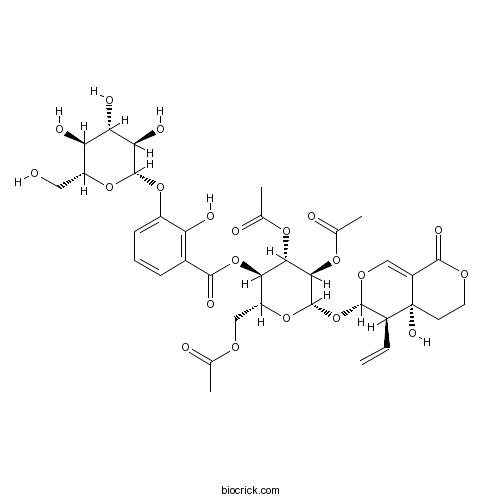GelidosideCAS# 128420-44-0 |

Quality Control & MSDS
3D structure
Package In Stock
Number of papers citing our products

| Cas No. | 128420-44-0 | SDF | Download SDF |
| PubChem ID | 46174003 | Appearance | Powder |
| Formula | C35H42O21 | M.Wt | 798.7 |
| Type of Compound | Iridoids | Storage | Desiccate at -20°C |
| Solubility | Soluble in Chloroform,Dichloromethane,Ethyl Acetate,DMSO,Acetone,etc. | ||
| Chemical Name | [(2R,3R,4S,5R,6S)-4,5-diacetyloxy-2-(acetyloxymethyl)-6-[[(3S,4R,4aR)-4-ethenyl-4a-hydroxy-8-oxo-3,4,5,6-tetrahydropyrano[3,4-c]pyran-3-yl]oxy]oxan-3-yl] 2-hydroxy-3-[(2S,3R,4S,5S,6R)-3,4,5-trihydroxy-6-(hydroxymethyl)oxan-2-yl]oxybenzoate | ||
| SMILES | CC(=O)OCC1C(C(C(C(O1)OC2C(C3(CCOC(=O)C3=CO2)O)C=C)OC(=O)C)OC(=O)C)OC(=O)C4=C(C(=CC=C4)OC5C(C(C(C(O5)CO)O)O)O)O | ||
| Standard InChIKey | XINNQYBYFFJBAM-OBOKACSWSA-N | ||
| Standard InChI | InChI=1S/C35H42O21/c1-5-18-32(49-12-19-31(45)47-10-9-35(18,19)46)56-34-29(51-16(4)39)28(50-15(3)38)27(22(54-34)13-48-14(2)37)55-30(44)17-7-6-8-20(23(17)40)52-33-26(43)25(42)24(41)21(11-36)53-33/h5-8,12,18,21-22,24-29,32-34,36,40-43,46H,1,9-11,13H2,2-4H3/t18-,21+,22+,24+,25-,26+,27+,28-,29+,32-,33+,34-,35+/m0/s1 | ||
| General tips | For obtaining a higher solubility , please warm the tube at 37 ℃ and shake it in the ultrasonic bath for a while.Stock solution can be stored below -20℃ for several months. We recommend that you prepare and use the solution on the same day. However, if the test schedule requires, the stock solutions can be prepared in advance, and the stock solution must be sealed and stored below -20℃. In general, the stock solution can be kept for several months. Before use, we recommend that you leave the vial at room temperature for at least an hour before opening it. |
||
| About Packaging | 1. The packaging of the product may be reversed during transportation, cause the high purity compounds to adhere to the neck or cap of the vial.Take the vail out of its packaging and shake gently until the compounds fall to the bottom of the vial. 2. For liquid products, please centrifuge at 500xg to gather the liquid to the bottom of the vial. 3. Try to avoid loss or contamination during the experiment. |
||
| Shipping Condition | Packaging according to customer requirements(5mg, 10mg, 20mg and more). Ship via FedEx, DHL, UPS, EMS or other couriers with RT, or blue ice upon request. | ||
| Description | Gelidoside is a natural product from Gentiana siphonantha. |
| In vitro | Secoiridoids from Gentiana siphonantha.[Pubmed: 9396170]Phytochemistry. 1997 Nov;46(6):1035-8.
|

Gelidoside Dilution Calculator

Gelidoside Molarity Calculator
| 1 mg | 5 mg | 10 mg | 20 mg | 25 mg | |
| 1 mM | 1.252 mL | 6.2602 mL | 12.5203 mL | 25.0407 mL | 31.3009 mL |
| 5 mM | 0.2504 mL | 1.252 mL | 2.5041 mL | 5.0081 mL | 6.2602 mL |
| 10 mM | 0.1252 mL | 0.626 mL | 1.252 mL | 2.5041 mL | 3.1301 mL |
| 50 mM | 0.025 mL | 0.1252 mL | 0.2504 mL | 0.5008 mL | 0.626 mL |
| 100 mM | 0.0125 mL | 0.0626 mL | 0.1252 mL | 0.2504 mL | 0.313 mL |
| * Note: If you are in the process of experiment, it's necessary to make the dilution ratios of the samples. The dilution data above is only for reference. Normally, it's can get a better solubility within lower of Concentrations. | |||||

Calcutta University

University of Minnesota

University of Maryland School of Medicine

University of Illinois at Chicago

The Ohio State University

University of Zurich

Harvard University

Colorado State University

Auburn University

Yale University

Worcester Polytechnic Institute

Washington State University

Stanford University

University of Leipzig

Universidade da Beira Interior

The Institute of Cancer Research

Heidelberg University

University of Amsterdam

University of Auckland

TsingHua University

The University of Michigan

Miami University

DRURY University

Jilin University

Fudan University

Wuhan University

Sun Yat-sen University

Universite de Paris

Deemed University

Auckland University

The University of Tokyo

Korea University
- Euojaponine D
Catalog No.:BCC8980
CAS No.:128397-42-2
- Hydroprotopine
Catalog No.:BCN6155
CAS No.:128397-41-1
- Hyptadienic acid
Catalog No.:BCN6154
CAS No.:128397-09-1
- MCH (human, mouse, rat)
Catalog No.:BCC6068
CAS No.:128315-56-0
- Cinalukast
Catalog No.:BCC7244
CAS No.:128312-51-6
- MK-8033 hydrochloride
Catalog No.:BCC4040
CAS No.:1283000-43-0
- 2alpha-Hydroxy-8beta-(2-methylbutyryloxy)costunolide
Catalog No.:BCN7319
CAS No.:128286-87-3
- Bivalirudin Trifluoroacetate
Catalog No.:BCC1421
CAS No.:128270-60-0
- 1-(3,4-Dimethoxycinnamoyl)piperidine
Catalog No.:BCN4036
CAS No.:128261-84-7
- Axillaridine A
Catalog No.:BCN6153
CAS No.:128255-16-3
- Pachyaximine A
Catalog No.:BCN6152
CAS No.:128255-08-3
- BAY-X 1005
Catalog No.:BCC6038
CAS No.:128253-31-6
- 2-Hydroxypropyl-β-cyclodextrin
Catalog No.:BCC6757
CAS No.:128446-35-5
- Methylophioponanone B
Catalog No.:BCN6525
CAS No.:128446-36-6
- Ophiogenin-3-O-alpha-L-rhaMnopyranosyl-(1→2)-beta-D-glucopyranoside
Catalog No.:BCN1587
CAS No.:128502-94-3
- Romidepsin (FK228, depsipeptide)
Catalog No.:BCC3597
CAS No.:128517-07-7
- GSK2578215A
Catalog No.:BCC6243
CAS No.:1285515-21-0
- ML167
Catalog No.:BCC5348
CAS No.:1285702-20-6
- Pingpeimine C
Catalog No.:BCN8411
CAS No.:128585-96-6
- Ospemifene
Catalog No.:BCC5557
CAS No.:128607-22-7
- Z(2-Br)-Osu
Catalog No.:BCC2806
CAS No.:128611-93-8
- PyBOP
Catalog No.:BCC2820
CAS No.:128625-52-5
- 1,6-O,O-Diacetylbritannilactone
Catalog No.:BCN7792
CAS No.:1286694-67-4
- FRAX597
Catalog No.:BCC4172
CAS No.:1286739-19-2
Secoiridoids from Gentiana siphonantha.[Pubmed:9396170]
Phytochemistry. 1997 Nov;46(6):1035-8.
Repeated fractionations of the methanol extract of the subterranean parts (rhizomes and roots) of Gentiana siphonantha afforded two new and five known secoiridoids, in addition to the widespread plant constituents beta-sitiosterol, daucosterol and oleanolic acid. The structures of the new acyl secoiridoid glycosides were elucidated as 6'-gentisoyl 8-epikingiside and 2'-gentisoyl Gelidoside mainly by a combination of high field NMR techniques. The known secoiridoids were identified as gentiolactone, gentiopicroside, sweroside, Gelidoside and trifloroside. None of these constituents was active against human pathogenic fungi (Candida albican, Aspergillus flavus and Trichoderma viride). The chemotaxonomic significance of the isolates is discussed briefly.


